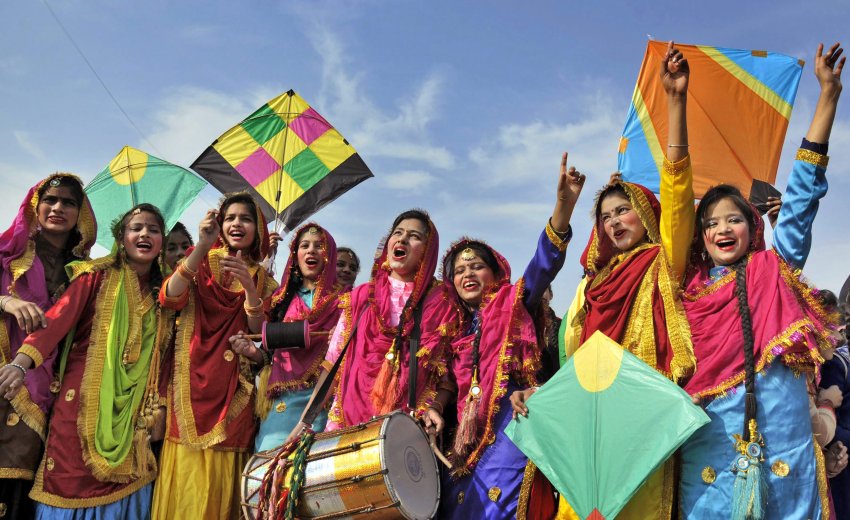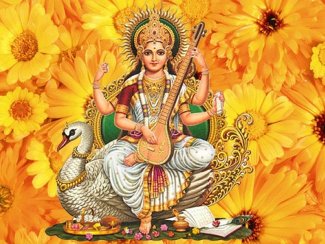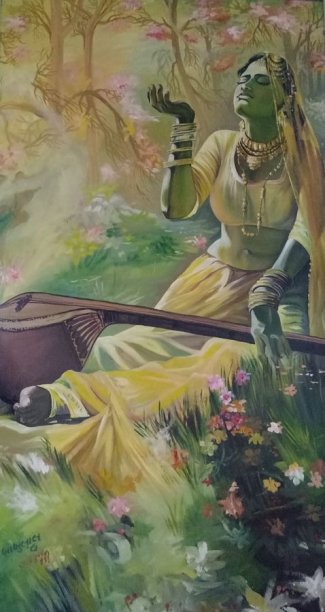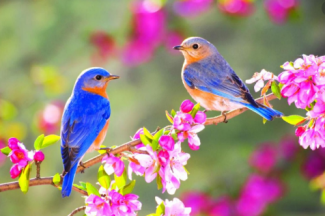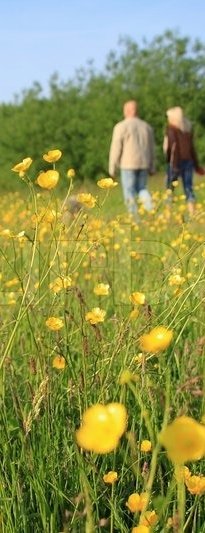Basant (Spring) is a time of dawning light, new life, new birth, and new hope — a time of warmth, vitality, dancing, and blossoming. Every year she comes out of the cold darkness and captivatingly dances around us. She embraces us with her warmth, intoxicates us with her aroma. Like a potent elixir, spring revitalizes our hope. She breathes life into the dead and teaches us the lessons of renewal and rebirth [1].
The dawn of Basant is well appreciated in Gurbani as;
ਮਾਹਾ ਮਾਹ ਮੁਮਾਰਖੀ ਚੜਿਆ ਸਦਾ ਬਸੰਤੁ ॥(ਮਹਲਾ ੧, SGGS, ਪੰਨਾ 1168)
Among the months, blessed is the month when spring always comes. (Mehl First, SGGS, p 1168)
ਰੁਤਿ ਆਈਲੇ ਸਰਸ ਬਸੰਤ ਮਾਹਿ ॥(ਮ. 1, SGGS, ਪੰਨਾ 1168)
The delightful season of spring has come. (Mehl First, SGGS, p 1168)
Every year, the vernal equinox occurs on the 21st of March. It indicates the starting of long, brighter days. The birds trill, bees buzz, and the buds of plants and trees burst forth. Humans stroll with a bit more spring in their step and sparkle in their eyes. Gurbani appreciates the blooming of Spring as;
ਬਸੰਤ ਰੁਤਿ ਆਈ ॥ ਪਰਫੂਲਤਾ ਰਹੇ ॥ (ਮਹਲਾ ੫, SGGS, ਪੰਨਾ 1185)
The season of spring has come. It blossoms forth luxuriantly. (Mehl Fifth, SGGS, p 1185)
Feeling good in spring is more than psychological. The more extended light period of spring days has the power to change our biochemistry in positive ways. The increased sunlight exposure affects hormonal and metabolic functions. We feel more optimistic and resilient; even our reproductive patterns are affected by the light of spring.
Spring celebrations in different cultures
As spring dawns, the world is filled with festivities and celebrations from all traditions and cultures [2-3]. The Spring season is associated with the blooming of a festive mood. Every community celebrates this joyous season differently.
Every year around the start of the Spring season, Christians worldwide celebrate Easter, a festival dedicated to the resurrection of Jesus Christ. On this day, many Christians end lent, a period preceding Easter where they avoid eating meat. Amid this period, many people, as a sign of sacrifice, quit their much-loved things. Some people quit eating meat. A few others stop drinking or smoking. On Easter, for the Christians, the day begins with prayer at the church. Lilies and Easter eggs are exchanged among families and friends. Every year, people buy beautiful, expensive dresses as a part of the celebration. Most of the Churches are decorated with bright colours of yellow, white and green. In Thailand, spring brings the Songkran Water Festival. Thailand’s New Year is celebrated from the 13th of April to the 16th. In Babylon, the spring season brings the 12-day religious festival, Kha b’ Nisan Assyrian, starting from April 1st celebrated by the Assyrians as their New Year.
One of the spring-themed festivals in Hindu culture is Vasant Panchami. Each year, it is celebrated on the 5th day of the bright half of the Indian month of Magh (February). Vasant Panchami initiates the festive spring cycle. This cycle's summation occurs with the Holi celebration. In ancient Indian tradition, Vasant Panchami is associated with the Shringara tradition, and the festival was celebrated in this tradition. Celebrations today still honour Kamadeva, his wife Rati, and his friend Vasant (the personification of Spring). The Hindu goddess of the Vasant Panchami festivities is Sarasvati. On this day, the Goddess Saraswati's worship has been well known since the Vedic and the Puranic periods. It is believed that Lord Brahma manifested Saraswati on this day so that the worldly beings could enjoy a life of intelligence, dialogue and harmony. Goddess Sarasvati is a beholder of the musical instrument Veena and is also called “Veena Vandini.”
Hindus also welcome the spring in the form of Holi, the famous festival of colours, on 27th March. According to Indian scriptures, on this day, Lord Vishnu came to protect his beloved devotee (Bhagat Prahlad) from being burnt alive. Therefore Holi marks a day to celebrate love and companionship. In India, the festival is also celebrated to rejoice in Lord Krishna’s love and colour each other in gulaal (red colour). It is a day to have fun. Elders and young children play alike with colours to express their affection to each other. There is a saying in society, ‘All grievances are pardoned today, and everyone gets together with a fresh start.’
The Basant season's celebration is an age-old cultural tradition of the Punjabi people. All people, including Hindus, Sikhs and Muslims, enjoy it with great joy and gusto. Yellow is the preferred colour of the day. It depicts the blooming spring flowers. It also represents the yellow mustard fields of Punjab. On this day, girls generally wear yellow dupattas and saris. Boys often include yellow turbans in their attire. There are no constraints of religions or different socio-economic classes. All get-together and celebrate the day. Usually, girls get on the swings and sing the traditional Basant songs. These songs reflect the excitement and romance of Punjabi life. Kite-flying is one of the main activities on the day. There are often a good number of competitions among people to cut loose others’ kites.
On the day of Vasant Panchmi, musicians in the Harmandir Sahib, Amritsar, start [3] the kirtan (music) by singing Basant Raga. This custom is continued until the first day of Vaisakh. Guru Hargobind Ji, the Sixth Sikh Guru, was born in 1595. To celebrate his birthday, a fair is held on Basant Panchmi at Chheharta Sahib Gurdwara in Wadali, near Amritsar. The main attraction of Basant at Chheharta Sahib is the kite flying practice, which is an ancient custom attached to the festival. On Basant Panchami day in 1677, Guru Gobind Singh, the tenth Sikh Guru, got married to Bibi Jeeto Ji at Guru Ka Lahore. Every year, on Basant Panchmi, a Nagar Kirtan is held from Guru Ka Lahore to Takhat Sri Kesgarh Sahib to celebrate the occasion.
Basant as a Metaphor
In Gurbani [4-5], the word ‘Basant’ has been used as a metaphor for several different things, e.g. a Season, a Raga (Melodic modes), a State of Mind, to Dwell, the springtime of the soul and the Divine.
Basant – A Season
The word ‘Basant’ is derived from the Sanskrit word "Vasant," meaning spring [6]. It is one of the four temperate seasons. It represents the transition time between winter and summer. In the Northern hemisphere, the Spring season is popularly considered to comprise March, April, and May. At the spring equinox, days are close to 12 hours long, with day length increasing as the season progresses.
In this season, the weather becomes warmer, and plants revive. Many flowering plants bloom. In spring, the earth's axis increases its tilt toward the Sun. The daylight's duration rapidly increases for the relevant hemisphere. Notably, the hemisphere begins to warm. This change causes new plant growth. This springing forth action of plants provides the basis for the name "Spring Season." In many parts of the world, snow begins to melt, and streams swell with runoff. Frosts become less severe. In snow/frosts free climates, the air and ground temperature increases more rapidly. Many flowering plants bloom, in a long succession, continuing into early summer [6-8].
Basant (Spring) is a season of rejuvenation and growth. As per the Indian calendar, it begins in the month of Chayt and continues during the month of Baisakh. The season of spring is pleasant and delightful. Some fascinating observations are reported in Gurbani as under;
ਚੜਿ ਚੇਤੁ ਬਸੰਤੁ ਮੇਰੇ ਪਿਆਰੇ ਭਲੀਅ ਰੁਤੇ ॥ (ਮ. 4, SGGS, ਪੰਨਾ 452)
In the month of Chayt, O my dear beloved, the pleasant season of spring begins. (Mehl Fourth, SGGS, p 452)
ਰੁਤਿ ਸਰਸ ਬਸੰਤ ਮਾਹ ਚੇਤੁ ਵੈਸਾਖ ਸੁਖ ਮਾਸੁ ਜੀਉ ॥(ਮ. 5, SGGS, ਪੰਨਾ 927)
The season of spring is delightful. The months of Chayt and Baisaakh are the most pleasant. (Mehl Fifth, SGGS, p 927)
In the spring season, all the plants and flowers blossom forth. All living beings experience a state of joy. The fact is proclaimed in Gurbani as;
ਬਨਸਪਤਿ ਮਉਲੀ ਚੜਿਆ ਬਸੰਤੁ ॥ (ਮਹਲਾ ੩, SGGS, ਪੰਨਾ 1176)
The season of spring has come. All the plants have blossomed forth. (Mehl Third, SGGS, p 1176)
ਚੇਤੁ ਬਸੰਤੁ ਭਲਾ ਭਵਰ ਸੁਹਾਵੜੇ ॥ ਬਨ ਫੂਲੇ ਮੰਝ ਬਾਰਿ ਮੈ ॥ (ਮਹਲਾ ੧, SGGS,ਪੰਨਾ 1107)
In the month of Chayt, the lovely spring has come. The bumblebees hum with joy. The forest is blooming in front of my door! (Mehl First, SGGS, p 1107)
Basant – A Raga (Melodic Modes)
The word ‘Raga’ in Sanskrit means “colour" or "mood." A Raga6-8 refers to melodic modes used in Indian classical music. It is a series of five or more musical notes upon which a melody is built. Each raga has a strict set of rules. These rules govern the number and types of notes and their interplay for a tune's composition.
In Indian musical custom, rāgas are related to different times of the day or seasons. Traditionally, Indian classical music is always set in a rāga. Indian non-classical music, e.g. film songs or ghazals, also sometimes use rāgas in their compositions.
Basant raga is an Indian musical melody dating back to the 8th century. It appears in the Sikh tradition from northern India and is part of the Sri Guru Granth Sahib. In Sri Guru Granth Sahib, out of 31 ragas, Basant is the series's 25th raga. The compositions in this raga appear on pages 1168 to 1197. Guru Nanak, Guru Amar Das, Guru Ram Das, Guru Arjan and Guru Tegh Bahadar composed their several verses in Basant raga.
During the Basant season, Basant raga may be performed at any time of the day or night. Generally, it is reserved for the time between 9 p.m. and midnight. This gentle melody, when performed in a slow tempo, depicts calmness and peaceful joy. At the beginning of a composition, a descending scale is usually found. An ascending form always follows it. Today Basant raga belongs to the Purvi thata. The Ragmala gives Basant as a putra (son) of Hindol, a spring raga. The only variant noted in the Holy Book is Basant-Hindol.
…… ਬਸੰਤੀ ਸੰਦੂਰ ਸੁਹਾਈ ॥ … ਗਾਵਹਿ ਸਰਸ ਬਸੰਤ ਕਮੋਦਾ ॥….
…… Basantee and Sandoor are melodious; ….. and the thrilling songs of Basant and Kamodaa are sung. (Raag Maalaa, SGGS, p 1430)
Basant – a Metaphor for ‘a State of Mind’
In Gurbani, the word ‘Basant’ is also used to denote a condition or mode of being, concerning circumstances such as a state of joy, happiness, bliss. Such a state leads to rejuvenation of body and mind. Thus the spirituality of spring is more about becoming than being. Gurbani commends meditation to obtain rejuvenation of body and mind.
ਮਨਿ ਬਸੰਤੁ ਹਰੇ ਸਭਿ ਲੋਇ ॥ ਫਲਹਿ ਫੁਲੀਅਹਿ ਰਾਮ ਨਾਮਿ ਸੁਖੁ ਹੋਇ ॥
When the mind experiences spring, all people are rejuvenated. Blooming forth and flowering through the Lord's Name, peace is obtained. (Mehl Third, SGGS, p 1176)
ਮਨਿ ਬਸੰਤੁ ਤਨੁ ਮਨੁ ਹਰਿਆ ਹੋਇ ॥ (ਮਹਲਾ ੩, SGGS, ਪੰਨਾ 1176)
When the mind experiences spring, the body and mind are rejuvenated. (Mehl Third, SGGS, p 1176)
ਸਾਚਿ ਰਤੇ ਤਿਨ ਸਦ ਬਸੰਤ ॥ ਮਨੁ ਤਨੁ ਹਰਿਆ ਰਵਿ ਗੁਣ ਗੁਵਿੰਦ ॥ (ਮਹਲਾ ੩, SGGS, ਪੰਨਾ 1173)
Those people, who are imbued with the Love of God, are in the bloom of spring forever. By uttering the Lord of the Universe's Glorious Praises, their minds and bodies are rejuvenated. (Mehl Third, SGGS, p 1173)
ਗੁਰ ਪਰਸਾਦਿ ਬਸੰਤੁ ਬਨਾ॥ ਚਰਨ ਕਮਲ ਹਿਰਦੈ ਉਰਿ ਧਾਰੇ ਸਦਾ ਸਦਾ ਹਰਿ ਜਸੁ ਸੁਨਾ॥ (ਮਹਲਾ ੫, SGGS, ਪੰਨਾ 1182)
With Guru's Grace, the spring of the soul has arrived. I enshrine the Lord's Lotus Feet of the Lord within my heart; I listen to the Lord's Praise, forever and ever. (Mehl Fifth, SGGS, p 1182)
Basant – a Metaphor for ‘To Dwell’
In Gurbani, the word ‘Basant’ is used to represent the state of dwelling in joy. Gurbani declares the omnipresence of God in the hearts of devotees as;
ਘਟਿ ਘਟਿ ਬਸੰਤ ਬਾਸੁਦੇਵਹ ਪਾਰਬ੍ਰਹਮ ਪਰਮੇਸੁਰਹ ॥(ਮਹਲਾ ੫, SGGS,ਪੰਨਾ 1356)
The Supreme Lord God, the Transcendent, Luminous Lord, dwells in every heart. (Mehl Fifth, SGGS, p 1356)
ਬਸੰਤਿ ਸਾਧ ਰਿਦਯੰ ਅਚੁਤ ਬੁਝੰਤਿ ਨਾਨਕ ਬਡਭਾਗੀਅਹ ॥ (ਮਹਲਾ ੫, SGGS, ਪੰਨਾ 1359)
The Imperishable Lord dwells in the hearts of the Holy. He is understood, O Nanak, by those who are very fortunate. (Mehl Fifth, SGGS, P 1359)
ਭਗਵਾਨ ਰਮਣੰ ਸਰਬਤ੍ਰ ਥਾਨ੍ਯ੍ਯਿੰ ॥ ਦ੍ਰਿਸਟ ਤੁਯੰ ਅਮੋਘ ਦਰਸਨੰ ਬਸੰਤ ਸਾਧ ਰਸਨਾ॥(ਮਹਲਾ ੫, SGGS, ਪੰਨਾ 1354)
God is pervading and permeating all places. So obtain the Blessed Vision of His Darshan; He dwells upon the tongues of the Holy. (Mehl Fifth, SGGS, p 1354)
Gurbani makes us aware that contemplation of Guru‘s Sabd leads to one‘s salvation from the cycles of birth and death.
ਹਰਿ ਦਰਗਹ ਸੋਭਾਵੰਤ ॥ ਫੁਨਿ ਗਰਭਿ ਨਾਹੀ ਬਸੰਤ ॥(ਮਹਲਾ ੫, SGGS, ਪੰਨਾ 898)
One, who is respected in the Court of the Lord, will not have to enter the womb of reincarnation ever again. (Mehl Fifth, SGGS, p 898)
Basant – a metaphor for ‘Springtime.’
The word ‘Basant’ is also used to denote a time of happiness, peace and tranquillity in one’s life. Usually, the most attractive period of a being is called ‘Springtime.’ Such a period can be a rejuvenation time. Gurbani proclaims that there are several acts (e., g. meditation, meeting the Divine Guru, receiving the Grace of the God, contemplation of Guru’s Sabd), which lead to the springtime of the human soul.
ਤਿਸੁ ਸਦ ਬਸੰਤੁ ਜਿਸੁ ਰਿਦੈ ਨਾਮੁ ॥ (ਮਹਲਾ ੫, SGGS,ਪੰਨਾ 1180)
A person within whose heart the Name of the Lord abides, he/she experiences the soul's eternal springtime. (Mehl Fifth, SGGS, p 1180)
ਤਿਸੁ ਬਸੰਤੁ ਜਿਸੁ ਪ੍ਰਭੁ ਕ੍ਰਿਪਾਲੁ ॥ (ਮਹਲਾ ੫, SGGS,ਪੰਨਾ 1180)
A person experiences the springtime of the soul, unto whom God grants His Grace. (Mehl Fifth, SGGS, p 1180)
ਸਦ ਬਸੰਤ ਗੁਰ ਮਿਲੇ ਦੇਵ ॥(ਮਹਲਾ ੫, SGGS, ਪੰਨਾ 1180)
It is always springtime when I meet the Divine Guru. (Mehl Fifth, SGGS, p 1180)
ਤਿਸੁ ਬਸੰਤੁ ਜਿਸੁ ਗੁਰੁ ਦਇਆਲੁ ॥ (ਮਹਲਾ ੫, SGGS, ਪੰਨਾ 1180)
A person, unto whom the Guru is compassionate, he experiences this springtime of the soul. (Mehl Fifth, SGGS, p 1180)
ਸਦਾ ਬਸੰਤੁ ਗੁਰ ਸਬਦੁ ਵੀਚਾਰੇ ॥ (ਮਹਲਾ ੩, SGGS, ਪੰਨਾ 1176)
Contemplating the Guru's Sabd, one is in spring forever, (Mehl Third, SGGS, p 1176)
The word dualism is obtained from the Latin word duo meaning "two." It denotes a state of two parts. Dualism is generally described as moral dualism (e.g. the conflict between good and evil), mind-body or mind-matter dualism (e.g. Cartesian Dualism) or physical dualism (e.g. the Chinese Yin and Yang). Gurbani warns us that if one is engrossed in the worldly passions, one cannot experience the springtime.
ਇਸੁ ਮਨ ਕਉ ਬਸੰਤ ਕੀ ਲਗੈ ਨ ਸੋਇ ॥ ਇਹੁ ਮਨੁ ਜਲਿਆ ਦੂਜੈ ਦੋਇ ॥(ਮਹਲਾ ੩, SGGS, ਪੰਨਾ 1176)
As this mind is burnt by duality and double-mindedness, so it is not even touched by spring. (Mehl Third, SGGS, p 1176)
However, Gurbani provides us with a beacon to achieve eternal spring in one’s life by the contemplation of God’s Name.
ਸਬਦੇ ਸਦਾ ਬਸੰਤੁ ਹੈ ਜਿਤੁ ਤਨੁ ਮਨੁ ਹਰਿਆ ਹੋਇ ॥ (ਮਹਲਾ ੩, SGGS, ਪੰਨਾ 1420)
The contemplation of the Sabd (Gurbai) brings eternal spring; it rejuvenates the mind and body. (Mehl Third, SGGS, p 1420)
Basant – a Metaphor for ‘Divine’
Wonder, amazement, awe, and gratitude are integral to the spirituality of spring. Using the metaphor of ‘Basant’ Gurbani encourages us to see the Divine in all creation.
ਆਪਿ ਬਸੰਤੁ ਜਗਤੁ ਸਭੁ ਵਾੜੀ ॥ (ਮ. 3, SGGS, ਪੰਨਾ 1177)
The Lord Himself is the season of spring. The whole world is His Garden. (Mehl Third, SGGS, p 1177)
Thus Sikhism emphasizes that Basant (Spring) and all otherworldly phenomena manifest an ultimate reality (God). He is seen as the essence of the blossoms and the multitude of things and events we observe. Gurbani proclaims that God is ever in the state of Spring and is the Primal cause of it.
ਮਾਹਾ ਰੁਤੀ ਮਹਿ ਸਦ ਬਸੰਤੁ ॥ ਜਿਤੁ ਹਰਿਆ ਸਭੁ ਜੀਅ ਜੰਤੁ ॥(ਮਹਲਾ ੩, SGGS, ਪੰਨਾ 1172)
Throughout the months and the seasons, the Lord is always in bloom. He rejuvenates all beings and creatures. (Mehl Third, SGGS, p 1172)
ਪਹਿਲ ਬਸੰਤੈ ਆਗਮਨਿ ਪਹਿਲਾ ਮਉਲਿਓ ਸੋਇ॥ ਜਿਤੁ ਮਉਲਿਐ ਸਭ ਮਉਲੀਐ ਤਿਸਹਿ ਨ ਮਉਲਿਹੁ ਕੋਇ॥ (ਮ. ੧, SGGS, ਪੰਨਾ 791)
Spring brings forth the first blossoms, but the Lord blossoms earlier still. By His blossoming, everything blooms; no one else causes Him to blossom forth. (Mehl First, SGGS, p 791)
Welcoming Spring in Our Life
Spring is always miraculous and astounding with its intricate details and abundance of flowering. Just think of the brilliant, blazing yellow of Forsythia bushes, gorgeous colours of lovely tulips, beautiful daffodils, delightful roses and the startling glory of the Weeping Cherry Trees. Neither we control such beauty nor invent it but are invited to behold and receive in gratitude. Spring invites us to be present in every moment and increase our awareness of the wonder of the evolutionary workings that results in spring's annual flowering.
Gurbani emphasizes reflecting on the wonders of Spring and contemplating on its Creator, who is all-pervading and is the caretaker of all. It is asserted such cogitation leads to an eternal state of peace, tranquillity and joy in one’s life.
ਪਹਿਲ ਬਸੰਤੈ ਆਗਮਨਿ ਤਿਸ ਕਾ ਕਰਹੁ ਬੀਚਾਰੁ ॥ ਨਾਨਕ ਸੋ ਸਾਲਾਹੀਐ ਜਿ ਸਭਸੈ ਦੇ ਆਧਾਰੁ ॥(ਮ. ੨, SGGS,p 791)
He blossoms forth even earlier than the spring; reflect upon Him. O Nanak, praise the One who provides sustenance to all. (Mehl Second, SGGS, p 791)
ਮਾਹਾ ਮਾਹ ਮੁਮਾਰਖੀ ਚੜਿਆ ਸਦਾ ਬਸੰਤੁ ॥ ਪਰਫੜੁ ਚਿਤ ਸਮਾਲਿ ਸੋਇ ਸਦਾ ਸਦਾ ਗੋਬਿੰਦੁ ॥ (ਮਹਲਾ ੧, SGGS, ਪੰਨਾ 1168)
Among the other months, that month, when spring arrives, is always blessed. O, my consciousness! Blossom forth forever by contemplating God (the Lord of the Universe). (Mehl First, SGGS, p 1168)
In the spring season, we each have the opportunity to plant new seeds of positive change in our lives. Winter keeps us indoors, looking inward. Spring takes us outside, out of our homes and out of ourselves. It is a perfect time to remember that each day is a new possibility. We have the opportunity to grow and develop, to be more thoughtful about our actions, and to bring more balance into our lives consciously. Gurbani urges us to renounce egotism and to adopt an attitude of compassion for all through the love for God.
ਦੇਖੁ ਫੂਲ ਫੂਲ ਫੂਲੇ ॥ ਅਹੰ ਤਿਆਗਿ ਤਿਆਗੇ ॥………ਹਰਿ ਚੇਤਿ ਮਨ ਮੇਰੇ ॥ (ਮਹਲਾ ੫, p 1185)
Behold the blooming flowers. The blossoms are blossoming forth! Renounce and abandon your egotism. ........... O my mind, be conscious of the Lord. (Basant, Fifth Mehl: p 1185)
Spring is the perfect time to positively change one’s life, as Nature provides powerful cues for new growth in it. Following ideas [9] may help you to make such a change a reality.
-
Feel the Power of Nature: Take a long, leisurely walk in the woods or the lush green fields or even just in your neighbourhood park. Experience the power of Nature all around you and within you. Know that this extraordinary force is available to you, and allow it to influence the course of your life and health.
-
Reinvent yourself: Spring is the time for renewal. It is time to let go of what you don't need (physical, mental, and emotional habits that undermine your health). It is time to bring in what you need anew (accepting positive health habits). Be more creative, or read your favourite book or sit quietly to meditate and listen. Try to spend more time in natural surroundings. It is always exhilarating to take hikes, plant a garden, or work in a community garden.
-
Support Body-Mind Happiness: Create a balanced fitness program to support your healthy body/mind happiness. Include some reflective practices such as stretching, yoga, meditation or chi gong; in such a program. Such activities help support renewal by giving your body time to gently de-stress.
-
Be Pragmatic: Visualize your Perfect Life, and nourish that vision through your cleansing and renewal process. Recognize the areas of your life that need a change. Plan specific improvements that integrate the essence of changing seasons.
-
Be Compassionate: Do something that uplifts your spirit, such as caring for a loved one or an elderly neighbour. Doing selfless service to others is key to completing the circle of life called Love.
-
Be Healthy: It is your healthy body that lets your spirit fly more freely. Nutritional supplements (vitamins, minerals, amino acids, and fatty acids) nourish and support your body and mind. The cleansing process de-stresses your body. It lets your energy rise and awakens your spirit. Savour freshly squeezed juices and herbal teas. Such acts provide you with the much-needed vitality and nourishment. So do the sprouts from seeds and grains, which are vital foods. Aromatherapy and smelling the heavenly sweetness of the spring flowers will soother your soul too.
-
Be Grateful: Be grateful to all the good things of life and especially to the earth for its abundant bounties available to all of us. Adopt an attitude of living in harmony with Nature. Be aware of the life cycle of things. Understand the real cost of products you use, such as plastics and chemical products. Adopt the methods of re-use and re-cycle.
Welcoming the spring in our lives, may all of us blossom forth with the flowers of Goodness, Love, Compassion, Gratitude and Grace!
References
-
http://www.alive.com/articles/view/21331/the_lessons_of_spring
-
http://thearchernews.wordpress.com/2013/03/21/spring-celebrations-in-dif...
-
(http://en.wikipedia.org/wiki/Basant_Kite_Festival_%28Punjab%29)
-
Sri Guru Granth Sahib, 1983, SGPC, Amritsar, pp 1- 1430.
-
Sant Singh Khalsa, English Translation of SGGS, http://www.srigranth.org/servlet/gurbani.gurbani?S=y(English translation of SGGS by Sant Singh Khalsa)
-
http://www.healthy.net/Health/Essay/10_Tips_for_Spring_Cleansing_Spiritu...
-----------------------------------------------------------------------------------------------------------------------------------------
* Director, Center for Understanding Sikhism, Mississauga, L5A 1Y7, ON, Canada, Website: c4usikhism.com Email: [email protected]
